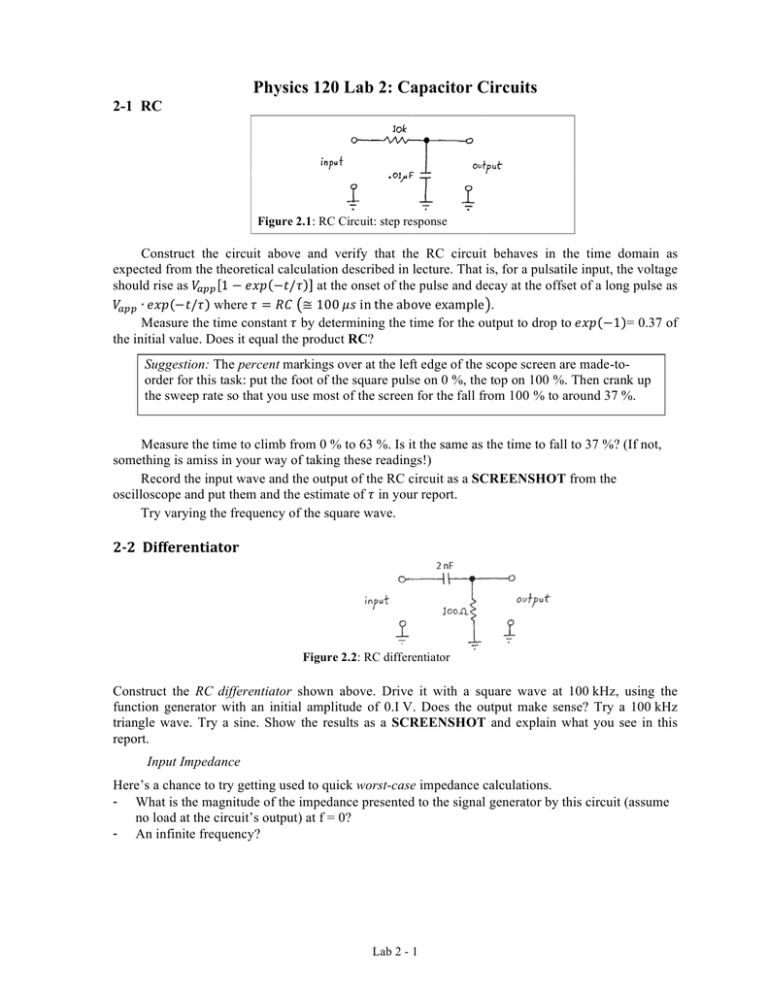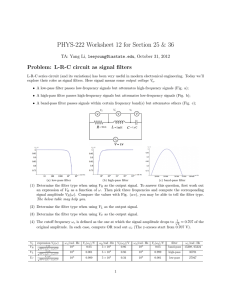Document 10904309
advertisement

Physics 120 Lab 2: Capacitor Circuits 2-1 RC Figure 2.1: RC Circuit: step response Construct the circuit above and verify that the RC circuit behaves in the time domain as expected from the theoretical calculation described in lecture. That is, for a pulsatile input, the voltage should rise as 𝑉!"" 1 − 𝑒𝑥𝑝 −𝑡/𝜏 at the onset of the pulse and decay at the offset of a long pulse as 𝑉!"" ∙ 𝑒𝑥𝑝 −𝑡/𝜏 where 𝜏 = 𝑅𝐶 ≅ 100 𝜇𝑠 in the above example . Measure the time constant 𝜏 by determining the time for the output to drop to 𝑒𝑥𝑝 −1 = 0.37 of the initial value. Does it equal the product RC? Suggestion: The percent markings over at the left edge of the scope screen are made-toorder for this task: put the foot of the square pulse on 0 %, the top on 100 %. Then crank up the sweep rate so that you use most of the screen for the fall from 100 % to around 37 %. Measure the time to climb from 0 % to 63 %. Is it the same as the time to fall to 37 %? (If not, something is amiss in your way of taking these readings!) Record the input wave and the output of the RC circuit as a SCREENSHOT from the oscilloscope and put them and the estimate of 𝜏 in your report. Try varying the frequency of the square wave. 2-­‐2 Differentiator Figure 2.2: RC differentiator Construct the RC differentiator shown above. Drive it with a square wave at 100 kHz, using the function generator with an initial amplitude of 0.I V. Does the output make sense? Try a 100 kHz triangle wave. Try a sine. Show the results as a SCREENSHOT and explain what you see in this report. Input Impedance Here’s a chance to try getting used to quick worst-case impedance calculations. - What is the magnitude of the impedance presented to the signal generator by this circuit (assume no load at the circuit’s output) at f = 0? - An infinite frequency? Lab 2 - 1 2-­‐3 Integrator Figure 2.3: RC integrator Construct the integrator shown above. Drive it with a 100 kHz square wave at maximum output level, about 10 V. Take a SCREENSHOT and report what you see. What is the input impedance at DC? At infinite frequency? Drive it with a triangle wave; what is the output waveform called? Show a SCREENSHOT. To expose this as only an approximate or conditional integrator, try dropping the input frequency. Take a SCREENSHOT and report what happens. Step your way down to 1 kHz or so. Are we violating the stated condition for situation. 2-­‐4 Low-­‐pass Filter Figure 2.4: RC low-pass filter Construct the low-pass filter shown above. Yes, this is the same as the "integrator" above. We are just going to look at its features in a different way. What do you calculate to be the filter’s -3 dB frequency, i.e., where 𝑓 = 1/ 2𝜋𝑅𝐶 ? Drive the circuit with a sine wave, sweeping over a large frequency range, to observe its low-pass property: the 1 kHz and 10 kHz ranges should be most useful. Note: Henceforth we will refer to “the 3 dB point” and “f3dB” and not to the minus 3 dB point. This usage is conventional. Find 𝑓!!" experimentally: measure the frequency at which the filter attenuates by 3 dB 𝑽𝒐𝒖𝒕 𝑑𝑜𝑤𝑛 𝑡𝑜 1 − 𝑒𝑥𝑝 −1 = 0.71 . Take a SCREENSHOT of the input and output signals. Suggestion: As you measure phase shift, use the function generator’s SYNC or TTL output to drive the scope’s External Trigger. That will define the input phase cleanly. The output signal, viewed at the same time, should reveal its phase shift readily. Finally, measure the attenuation figures starting at 𝑓 = 0.1𝑓!!" and extend to 𝑓 = 10𝑓!!" in about 20 logarithmically-spaced steps (10 per decade). Plot these the magnitude of these data on a log-log scale, either by hand or with a program: this is called a Bode plot. Why is a log-log plot useful? Submit a copy of the plot in your report. We will compare this filter against one (section 2.7) that shows a steeper roll-off. Plot the phase shift on a linear-log plot. Submit this as well. What is the limiting phase shift, both at very low and at very high frequencies? Lab 2 - 2 2-5 High-pass Filter Figure 2.5: RC high-pass filter Construct a high-pass filter with the components that you used for the low-pass. Choose a reasonable voltage for a sine output and determine this circuit’s 3 dB point. Check to see if the output amplitude at low frequencies (well below the 3 dB point) is proportional to frequency. What is the limiting phase shift, both at very low frequencies and at very high frequencies? Report your results, including one or more SCREENSHOTS. 2-6 High-pass Filter Figure 2.6: High-pass filter applied to the 60Hz AC power The circuit above will let you see the “electronic garbage” on the 110-Volt power line. First look at the output of the transformer, at point A. It should look more or less like a classical sine wave. (The transformer reduces the 110 VAC to a more reasonable 6.3 V and it “isolates” the circuit we’re working on from the potentially lethal power line voltage). To see glitches and wiggles, look at point B, the output of the high-pass filter. All kinds of interesting stuff should appear, some of it curiously time-dependent. What is the filter’s attenuation at 60 Hz? (No complex arithmetic is necessary; use the fact, which you confirmed above, that amplitude grows linearly with frequency well below f3dB). Document your finding(s) with a SCREENSHOT. 2-­‐7 Filter Application II: Selecting signal from signal plus noise Figure 2.7: Composite signal, consisting of two sine waves. Note: The output of the transformed is now is series and "floats"; the 1 kΩ resistor protects the function generator in case the composite output is accidentally shorted to ground Now we will try using a high-pass filter to attenuate a large 60 Hz sine wave (peak value above 10 Volts) that adds to the output of the function generator. Pick reasonable values for the function generator output, say a 10 V sine wave at 10 kHz Lab 2 - 3 The 60 Hz is considered “noise” in this example. Thus run the composite signal through the high-pass filter shown below. Figure 2.8: High-pass filter Look at the resulting signal. Calculate the filter’s 3 dB point; show a SCREENSHOT that illustrates the filtering. Is the attenuation of the 60 Hz waveform about what you would expect? 2-8 LC Filter Figure 2.10: A very sharp low-pass filter It is possible to construct filters (high pass, low pass, etc.) with a frequency response that is far more abrupt than that of the simple RC filters you have been building. To get a taste of what can be done, build the filter shown above. It should have a 3 dB point of about 16 kHz and 𝑽𝒐𝒖𝒕 should drop like a rock at higher frequencies. Measure its 3 dB frequency, then measure its response starting at 𝑓 = 0.1𝑓!!" and extend to 𝑓 = 10𝑓!!" in about 20 logarithmically-spaced steps, like in section 2.4. Plot the magnitude of these data on a log-log scale (Bode plot) and submit the plot. Compare these measurements against the response of the RC low-pass filter that you measured in section 2.4. The best way to enjoy the performance of this filter is to sweep the frequency. See if you can take a SCREENSHOT of the effect (optional). You may, incidentally, find that the frequency range where the filter passes nearly all the signal is actually not quite flat; dips and bump result from using standard values of R and C, and the tolerance of these components, rather than using exactly the values called for. Note: One must give a common-sense redefinition to “f3dB” of this LC filter, because the filter attenuates to ½ amplitude even at DC. One must define the LC’s 3 dB point as the frequency at which the output amplitude is down 3 dB relative to its amplitude at DC. You will need to modify the meaning of “3 dB point” yet again when you meet amplifiers. Lab 2 - 4





